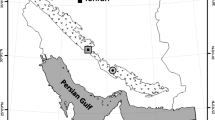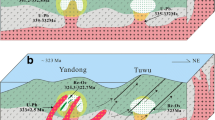Abstract
The Darrehzar porphyry Cu-Mo deposit is located in Southwestern Iran (∼70 km southwest of Kerman City). The porphyries occur as Tertiary quartz-monzonite stocks and dikes, ranging in composition from microdiorite to diorite and granodiorite. The Darrehzar stock is highly altered, and even in the outermost part of the intrusion, it is not possible to find completely fresh rock. Surface weathering was developing ferrous Fe-rich lithologic units in leached zone and concentrated copper minerals in supergene zone. Unlike eastern areas which do not account for deep faults, the supergene zone is well developed in western areas with maximum of 118 m thickness. Hydrothermal alteration and mineralization at Darrehzar are centered on the stock and were broadly synchronous with its emplacement. Early hydrothermal alteration was dominantly potassic and propylitic, and was followed by later phyllic and argillic alteration. The hydrothermal system involved both magmatic and meteoric water and boiled extensively. Copper mineralization was accompanied by both potassic and phyllic alteration. Four main vein groups have been identified: (I) quartz + pyrite ± molybdenite ± anhydrite ± K-feldspar ± chalcopyrite ± bornite ± Cu and Fe oxidic minerals (peripheral); (II) quartz + chalcopyrite + pyrite + molybdenite; (III) quartz + pyrite ± calcite ± chalcopyrite ± anhydrite (gypsum); and (IV) quartz or calcite, gypsum or ± pyrite. Based on abundance, nature, and phases number observed at room temperature, three types of fluid inclusions are typically observed in these veins: (1) vapor-rich, (2) liquid-rich, and (3) multi-phase. Early hydrothermal alteration was caused by high temperature, high salinity orthomagmatic fluid and produced a potassic assemblage. Phyllitic alteration was caused by high salinity and lower temperature orthomagmatic fluid. Magmatic and meteoric water mixture was developed in the peripheral part of the stock and caused propylitic alteration which is attributed to a liquid-rich, lower temperature.















Similar content being viewed by others
References
Asghari O, Hezarkhani A (2010) Investigations of alteration zones based on fluid inclusion microthermometry at Sungun porphyry copper deposit NW Iran. Mineral Res Expl Bull 140:19–34
Beane RE, Titley SR (1981) Porphyry copper deposits, Part II, Hydrothermal alteration and mineralization. Econ Geol 75th anniversary volume:235–269
Berberian M (1976) An explanatory note on the first seismotectonic map of Iran; a seismotectonic review of the country. In: Geological survey of Iran, Report No. 39, pp 7–142
Berberian M (1983) The southern Caspian: a compressional depression floored by a trapped, modified oceanic crust. Can J Earth Sci 20:163–183
Berberian M, King GC (1981) Towards a paleogeography and tectonic evolution of Iran. Can J Earth Sci 18:210–265
Bodnar RJ (1993) Revised equation and table for determining the freezing point depression of H2O–NaCl solutions. Geochim Cosmochim Acta 57:683–684
Bodnar RJ (1994) Synthetic fluid inclusions. XII. Experimental determination of the liquidus and isochores for a 40 wt.% H2O–NaCl solution. Geochim Cosmochim Acta 58:1053–1063
Bodnar RJ (2003) Introduction to aqueous fluid systems. In: Samson I, Anderson A, Marshall D (eds) Fluid inclusions: analysis and interpretation. Short Course 32. Mineralogical Association of Canada, Quebec, pp 81–99
Burnham CW (1979) Magmas and hydrothermal fluids. In: Barnes HL (ed) Geochemistry of hydrothermal ore deposits. Wiley, New York, pp 71–136
Calagari AA (2004) Fluid inclusion studies in quartz veinlets in the porphyry copper deposit at Sungun, East-Azarbaidjan, Iran. J Asian Earth Sci 23:179–189
Cannell J, Cooke DR, Walshe JL, Stein H (2005) Geology, mineralization, alteration, and structural evolution of the El Teniente porphyry Cu-Mo deposit. Econ Geol 100:979–1003
Derakhshani R, Abdolzadeh M (2009) Geochemistry, mineralization and alteration zones of Darrehzar porphyry copper deposit, Kerman, Iran. J Appl Sci 9:1628–1646
Dilles JH, Einaudi MT (1992) Wall-rock alteration and hydrothermal flow paths about the Ann-Mason porphyry copper deposits, Nevada—a 6-km vertical reconstruction. Econ Geol 87:1963–2001
Etminan H (1977) The discovery of porphyry copper–molybdenum mineralization adjacent to Sungun village in the northwest of Ahar and a proposed program for its detailed exploration. Confidential Report, Geological Report. Geological Survey of Iran, p 26
Geological Survey of Iran (GSI) (1973) Exploration for ore deposit in Kerman Region. Report Yu/53. Geological Survey of Iran, 220 p
Grujicic B, Volickovic S (1991) Copper deposit Darrehzar mineral inventories computation. Internal Report. National Iranian Copper Industries, Exploration Department, 27 p
Gustafson LB, Hunt JP (1975) The porphyry copper deposit at El Salvador, Chile. Econ Geol 70:857–912
Gustafson LB, Quiroga J (1995) Patterns of mineralization and alteration below the porphyry copper orebody at El Salvador, Chile. Econ Geol 90:2–16
Habibi T, Hezarkhani (2012) Hydrothermal evolution of Daraloo porphyry copper deposit, Iran: evidence from fluid inclusions. Arab J Geosci, 1-11
Haynes FM (1984) Vein densities in drill core, Sierrita porphyry copper deposit, Pima County, Arizona. Econ Geol 79:755–758
Hedenquist JW, Richards JP (1998) The influence of geochemical techniques on the development of genetic models for porphyry copper deposits. In: Richards JP, Larson PB (eds) Techniques in hydrothermal ore deposits geology. Rev Econ Geol 10:235–256
Hezarkhani A (2006) Hydrothermal evolutions at the Sar-Cheshmeh porphyry Cu–Mo deposit, Iran: evidence from fluid inclusions. J Asian Earth Sci Engl 28:408–422
Hezarkhani A (2008) Hydrothermal evolution of the Miduk porphyry copper system, Kerman, Iran: a fluid inclusion investigation. Int Geol Rev 50:1–20
Hezarkhani A (2009) Hydrothermal fluid geochemistry at the Chah-Firuzeh porphyry copper deposit, Iran: evidence from fluid inclusions. J Geochem Explor 101:254–264
Hezarkhani A, Williams-Jones AE (1998) Controls of alteration and mineralization in the Sungun porphyry copper deposit, Iran: evidence from fluid inclusions and stable isotopes. Econ Geol 93:651–670
Hunt JP, Bratt JA, Marquardt JC (1983) An enriched porphyry copper deposit, Quebrada Blanca, Chile. Min Eng 35:636–644
Maanijou M (1993) Alteration halos and their connection to mineralization of Darrehzar porphyry Cu deposit and its geochemical zoning, Pariz area, Kerman, Iran. M.Sc. Thesis (in Farsi), Shahid Beheshti University, Tehran, 254 p
Masterman GJ, Cooke DR, Berry RF, Walshe JL, Lee AW, Clark AH (2005) Fluid chemistry, structural setting, and emplacement history of the Rosario Cu-Mo porphyry and Cu-Ag-Au epithermal veins, Collahuasi district, northern Chile. Econ Geol 100:835–862
Mehrpartou M (1993) Contributions to the geology, geochemistry, ore genesis and fluid inclusion investigations on Sungun Cu-Mo porphyry deposit, northwest of Iran. Ph.D. Thesis. University of Hamburg, Germany, 245 p
National Industry Copper Company (2008) Darrehzar porphyry copper deposit (internal report for National Industry Copper Company in Persian)
Pollard PJ, Taylor RG (2002) Paragenesis of the Grasberg Cu-Au deposit, Irian Jaya, Indonesia: results from logging section 13. Miner Deposita 37:117–136
Pourhosseini F (1981) Petrogenesis of Iranian plutons: a study of the Natanz and Bazman intrusive complexes. Ph.D. Thesis. University of Cambridge, Cambridge, 315 p
Ranjbar H, Hassanzadeh H, Torabi M, Ilaghi O (2001) Integration and analysis of airborne geophysical data of the Darrehzar area, Kerman Province, Iran, using principal component analysis. J Appl Geophys 48:33–41
Redmond PB, Einaudi MT, Inan EE, Landtwing MR, Heinrich CA (2004) Copper deposition by fluid cooling in intrusion centered systems: new insights from the Bingham porphyry ore deposit, Utah. Geology 32:217–220
Roedder E (1984) Fluid Inclusions: Mineralogical Society of America. Reviews in Mineralogy v.12 644 p
Shahabpour J (1982) Aspects of alteration and mineralization at the Sar-Cheshmeh copper–molybdenum deposit, Kerman, Iran. Ph.D. thesis. Leeds University, Leeds, 342 p
Shahabpour J, Doorandish M (2008) Mine drainage water from the Sar Cheshmeh porphyry copper mine, Kerman, IR Iran. Environ Monit Assess 141:105–120
Sillitoe RH (1997) Characteristics and controls of the largest porphyry copper-gold and epithermal gold deposits in the circum-Pacific region. Aust J Earth Sci 44:373–388
Sillitoe RH (2010) Porphyry copper systems. Econ Geol 105:3–41
Sterner SM, Hall DL, Bodnar RJ (1988) Synthetic fluid inclusions. V. Solubility of the system NaCl–KCl–H2O under vapor-saturated conditions. Geochim Cosmochim Acta 52:989–1005
Stocklin JO (1977) Structural correlation of the Alpine ranges between Iran and Central Asia. Mem H Aser Soc Geol France 8:333–353
Stocklin J, Setudenia A (1972) Lexique Stratigraphique International Volume III ASIE. Centre National de la Recherche Scientifique. 15, quai Anatole-France 75 p (Paris-VII)
Ulrich T, Günther D, Heinrich CA (2001) The evolution of a porphyry Cu-Au deposit, based on LA-ICP-MS analysis of fluid inclusions: Bajo de la Alumbrera, Argentina. Econ Geol 96:1743–1774
Waterman GC, Hamilton RL (1975) The Sar-Cheshmeh porphyry copper deposit. Econ Geol 70:568–576
Were RW Jr, Bodnar RJ, Bethke PM, Barton PB (1979) A novel gas-flow fluid inclusion heating-freezing stage (Abstract). Geol Soc Am Abstracts and Programs 11:539
Wilkinson JJ (2001) Fluid inclusions in hydrothermal ore deposits. Lithos 55:229–272
Author information
Authors and Affiliations
Corresponding author
Rights and permissions
About this article
Cite this article
Alizadeh Sevari, B., Hezarkhani, A. Hydrothermal evolution of Darrehzar porphyry copper deposit, Iran: evidence from fluid inclusions. Arab J Geosci 7, 1463–1477 (2014). https://doi.org/10.1007/s12517-012-0744-x
Received:
Accepted:
Published:
Issue Date:
DOI: https://doi.org/10.1007/s12517-012-0744-x




